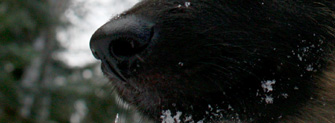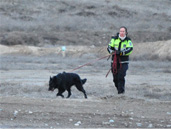| The Belgian Shepherd
Belgian Shepherd Dog (also known as the Belgian Sheepdog or Chien de Berger Belge) can refer to any of four varieties of dog: the Groenendael, the Laekenois, the Tervuren, or the Malinois. At times in history, there were other "varieties" as well. The brindle became known as the Dutch Shepherd (both a long-haired, and short-haired variety) when not permitted for registry as a Belgian by the FCI. The FCI has recently (2012) announced that it will now allow the crossing of Malinois and Groenendael, which produces a short-coated black dog, previously not permitted. In Europe and Canada, the Belgian Shepherd is one breed. The same applies in the United States with the UKC registry, but not with the American Kennel Club (AKC).
The AKC recognizes the four varieties of Belgian Shepherd as separate breeds: Groenendael under the name "Belgian Sheepdog," Tervuren as the Belgian Tervuren, and the Malinois as the Belgian Malinois.. This means that a Belgian of the Tervuren variety being born to Groenendael type parents in the AKC would have to be registered as Belgian Sheepdog, and be unable to compete in conformation events in AKC. These dogs could however register with CKC or UKC and be shown in conformation in those forums. The Laekenois can be registered as part of the AKC foundation stock service and should eventually be recognised fully by the AKC. The varieties differ only in their coats and superficially in appearance, with variations in "type," temperament and energy levels varying by bloodline.
They are so closely related that, when breeding any two dogs of the same coat colour and length (eg Groenendael), it is possible for puppies of different "breeds" to be in the same litter. For example, a Groenendael litter could contain a Tervuren puppy.
Belgian Shepherds can be intense working dogs, or reasonably calm companions, based on the pedigree, training and daily exercise regime. It can be said that they are all highly intelligent, and so, giving them nothing to do will result in a dog that creates self-rewarding, or self-destructive behaviors. It is generally agreed that Belgian Shepherds do not make a good "first dog" for those not experienced with handling dogs, though I'd say those who have grown up training horses might be an exception.
Temperament
While the original standards called for the Belgian Shepherds to be aloof and protective of their family, today's society favors highly social dogs. While today's Belgian Shepherds may not all be social butterflies, a great many of them are. They are, as stated, highly intelligent and are bred to be alert and sensitive to everything going on around them, and to develop extremely strong relationship bonds. Significant socialization of puppies will generally work in favor of producing a well adjusted and confident adult dog. Most Belgians prefer the company of "their human" to the companionship of other dogs, except at play time. Often even the human is their favorite playmate. Generally Belgians prefer to be doing SOMETHING rather than NOTHING.
Training
Belgian Shepherds are highly trainable, and favor positive reinforcement training over corrective or forceful methods.They can be completely put off by a lack of enthusiasm and praise from their handlers. They excel in scent/detection work, herding, agility and obedience. If the pedigree produces "harder" dogs, they can excel in protection sports, such as IPO and Ring Sports. Many dogs bred for this type of work are found in law enforcement and military professions. Pedigrees that produce dogs with high drives and stamina will also often produce dogs that excel in Search and Rescue and Herding. Belgians bred for work will be happiest working all day with their handler, as opposed to being tossed in the yard for exercise. Belgians can also perform as Service and Therapy Dogs. They resent being drilled in training exercises, and are easily offended by correction.
Health
It has been reported that Belgian Shepherds suffer a 17% rate of Idiopathic Epilepsy, and that there are no bloodlines 100% free of the occurence of seizures. That being said, it behooves all buyers to inquire about the health history of a pedigree when searching for their next Belgian. Other issues known to occurr are cancers and auto-immune disease. Of particular note is the increasing occurance of gastric carcinoma. There are some pedigrees known to produce osteosarcoma and other forms of cancer. Again, it is important to investigate risk factors and make an informed decision about your acceptable levels of risk. Other issues which can and do occurr in the Belgian Shepherd include cataracts and hip or elbow displasia. These can be genetic traits, and inquiring with a breeder about health history and health guarantees is part of the buyer's homework. Of course one should remember, that all dogs must die of something. So in your inquiries, it would be pertinent to note at what AGE the relatives of a prospective puppy have lived to. Aunts and uncles that lived to be 14 before succumbing to cancer or other illness is not nearly so significan as relatives losing a battle to hermangiosarcoma or gastric carcinoma at age 6 or 8.
Other factors to consider when assessing the health risks of a pedigree are environmental and medical factors. There are many research studies indicating increased occurance of auto-immune diseases in vaccinated pets, and 4 to 5 x greater occurrence of hermangiosarcoma and osteosarcomman in dogs having early (prior to 18 months) gonadectomy, and a higher occurrence of cancer to all dogs that have been altered at any age.
Mortality
Median longevity of Belgian Shepherds (all varieties combined) in the 2004 UK survey, was 12.5 years, both for purebred dogs in general and for breeds similar in size.[6] The longest-lived of 113 deceased Belgians in the UK survey was 18.2 years.] Leading causes of death were cancer (23%), cerebral vascular, i.e., stroke (13%), and old age (13%). Breed longevities in USA/Canada surveys are usually shorter than those in UK surveys.[1][2]
1. ^ a b c d e f http://www.thekennelclub.org.uk/item/570 Kennel Club/British Small Animal Veterinary Association Scientific Committee. 2004. Purebred Dog Health Survey. Retrieved July 5, 2007
2. ^ http://users.pullman.com/lostriver/survey_comparisons.htm Dog Longevity Web Site, Survey Comparisons page. Compiled by K. M. Cassidy. Retrieved July 5, 2007
|













